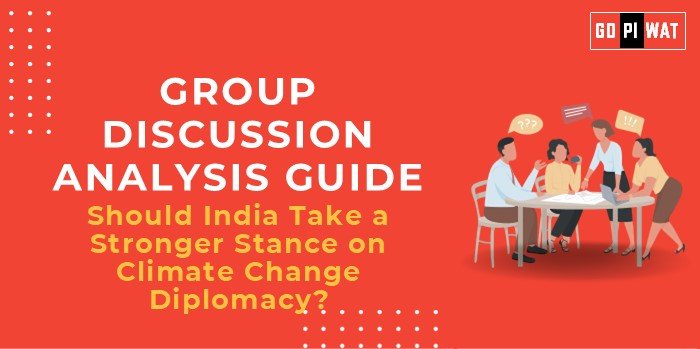📋 Group Discussion (GD) Analysis Guide: Should India Take a Stronger Stance on Climate Change Diplomacy?
🌐 Introduction
Opening Context: As the world grapples with the existential threat of climate change, India, being the third-largest CO₂ emitter, plays a critical role in global climate diplomacy. Its position as a developing nation with ambitious sustainability goals adds complexity to its responsibilities on the international stage.
📊 Quick Facts and Key Statistics
- 🌍 Global Emission Rank: 3rd largest CO₂ emitter, contributing 7% to global emissions.
- ♻️ Net-Zero Commitment: Achieving net-zero emissions by 2070, with interim targets of 500 GW non-fossil energy capacity and meeting 50% energy needs from renewables by 2030.
- 🔋 Renewable Energy Capacity: Over 200 GW installed as of December 2024, progressing toward a 500 GW target by 2030.
- ⚠️ Climate Impact: 80% of India’s population resides in districts vulnerable to climate-induced disasters like floods, droughts, and cyclones.
🧩 Stakeholders and Their Roles
- 🏛️ Government: Setting ambitious targets, implementing climate policies, and negotiating on global platforms.
- 💼 Private Sector: Developing renewable energy solutions and financing green innovations.
- 🌍 NGOs and Citizens: Advocating for climate justice and promoting grassroots-level action.
- 🌐 International Bodies: UNFCCC and IPCC supporting frameworks for climate action and financing.
🏆 Achievements and Challenges
- 🌟 Achievements:
- Renewable Energy Growth: Installed capacity surpassing 200 GW as of 2024, showcasing commitment to clean energy.
- Solar Leadership: Hosting the International Solar Alliance, emphasizing collaborative solar energy adoption.
- Afforestation Efforts: Programs like CAMPA aim to offset emissions through increased green cover.
- ⚠️ Challenges:
- Development vs. Sustainability: Balancing economic growth with environmental targets.
- Vulnerability to Disasters: Over 80% of the population is exposed to climate risks, threatening livelihoods.
- Funding Gap: Requires $2.5 trillion for climate actions by 2030.
🌐 Global Comparisons
- 🇨🇳 China: Leading in green technology investment, surpassing $546 billion in 2023.
- 🇪🇺 European Union: Aggressive carbon neutrality policies with a net-zero goal by 2050.
💡 Effective Discussion Approaches
- 📈 Opening Approaches:
- Data-Driven Start: “India contributes 7% to global CO₂ emissions and houses 80% of its population in climate-prone areas. Should this drive a firmer stance in climate diplomacy?”
- Contrast Perspective: “While India’s renewable energy capacity exceeds 200 GW, its population faces escalating climate disasters. Can we afford to wait?”
- Case Study Opening: “India’s renewable success, like the 100% solar-powered village of Modhera, showcases its potential.”
- 🎯 Counter-Argument Handling:
- Equity Emphasis: Highlight the principle of “common but differentiated responsibilities.”
- Progress Showcase: Stress achievements in renewable energy and international solar initiatives.
🔍 Strategic Analysis of Strengths and Weaknesses
- 🏅 Strengths: Rapid renewable energy growth, strong diplomatic leverage in international forums.
- ⚠️ Weaknesses: High dependency on fossil fuels, limited financial resources for large-scale transitions.
- 🌟 Opportunities: Green financing mechanisms, expansion of global partnerships.
- ⚡ Threats: Escalating climate disasters, international pressure for stricter commitments.
🖋️ Structured Arguments for Discussion
- ✅ Supporting Stance: “A firmer stance will enhance India’s global leadership, attract green funding, and safeguard vulnerable populations.”
- ❌ Opposing Stance: “Pushing too hard on climate commitments may hinder economic growth and industrial development.”
- ⚖️ Balanced Perspective: “India must lead diplomatically while balancing developmental priorities and equity in emission reductions.”
📄 Connecting with B-School Applications
- 🌍 Real-World Applications:
- Finance: Strategies for green financing and investment in renewables.
- Operations: Supply chain resilience for clean energy initiatives.
- Development: Policies to mitigate climate disaster impacts.
- 📚 Sample Interview Questions:
- “What role should India play in achieving global climate neutrality?”
- “How can climate diplomacy influence corporate sustainability?”
- ✨ Insights for Students:
- Opportunities in green finance.
- Developing solutions for energy efficiency and carbon reduction.
V


